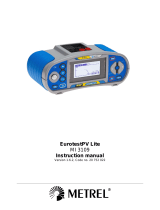10
2. INTRODUCTION
Photovoltaic systems are made up of two fundamental blocks:
Photovoltaic generator made up of one or more strings of photovoltaic modules that generates a direct current.
Inverter that converts the direct current generated by the modules into alternating current that can be fed it into the
grid.
The PHOTOVOLTAIC TEST FTV500 is a instrument designed and manufactured to meet all the needs of the technicians during
the installation, testing, commissioning, troubleshooting and maintenance of the photovoltaic generator or array according to
international standards.
The PHOTOVOLTAIC TEST FTV500 instrument is a tool that can be used on most PV systems connected to the 50Hz, 60Hz
and DC distribution networks in the world, with varying wiring systems. The instrument is designed to operate in environments
up to 1000V CAT III, 600V CAT IV depending on the selected test feature (check the characteristics in the appropriate section
of this user manual beforehand).
The instrument has been designed for carrying out the following tests:
EFFICIENCY: verification of operation and DC / AC efficiency on three-phase photovoltaic installations, measurement
of the PR (performance ratio, according to the CEI 82-25 guide; Variant 2, IEC / EN62446.
DC / AC current measurement (at 3 DC + 3 AC inputs) and DC / AC voltage measurement (3 AC + 3 DC inputs)
LOGGING: programmed recording (with programmable sampling frequency, and recording schedule) of the
parameters related to the EFFICIENCY test. Evaluation of the PV system efficiency in the short / long term.
I-V CURVE: verification of the I-V curve characteristicof PV modules / strings / arrays in order to check the parameters
declared by the manufacturer, according to IEC / EN 60891, IEC / EN 62446, IEC / EN 60904-5.
Series Resistance (RS) measurement, according to IEC / EN 60891.
RAPID TEST: rapid pre- test of open circuit voltage and short-circuit current of PV modules / strings / arrays, according
to IEC / EN 62446.
INSULATION / CONTINUITY: insulation resistance of modules / strings / arrays, according to the IEC / EN 62446.
Test of earth continuity according to IEC / EN 61557-4, IEC / EN 60364.
For the EFFICIENCY test, the PHOTOVOLTAIC TEST FTV500 has three voltage inputs (V-DC) and three current inputs (I-DC)
for the measurement of what is supplied by the photovoltaic generator. Thye instrument allows up to three strings of solar panels
to be measured simultaneously. Depending on the needs, one, two or all three V-DC and I-DC inputs can be used.
For the AC there are three inputs for voltage measurements (V-AC) and three inputs for current measurements (I-AC), which
allow measurements on single-phase, two-phase or three-phase systems.
Make sure that the voltage and current connections are correct, to avoid acquiring incorrect measurements.
After having duly entered all the electrical parameters of the photovoltaic system in the registry, the user can verify the correct
compliance of the measures compared with what is required by the standards, with the outcome of the measurement (OK / NO).
For the I-V CURVE test, the PHOTOVOLTAIC TEST FTV500 instrument has two inputs, one for the voltage measurement (V-
DC) and one for the current measurements (I-DC). The measurements can be made both on the single module and on a string
of modules, but keep in mind that the latter measurement is not covered by the standard.
All electrical data measured in the real operational test condition (OPC) are "translated" to the standard conditions (STC:
Standard Test Condition) of irradiation equal to 1000 W/m2 and module temperature equal to 25 °C, applying the calculation
formulas according to the IEC / EN 60891 standard.
The user can request the comparison (DPmax) between the value of the rated power (Pmax), with the power value measured
during the test (OPC) translated to the standard conditions STC (in accordance with IEC / EN 60891).
If the result of the comparison falls within the tolerance margin declared by the manufacturer, the test result will be "OK",
otherwise the test result will be "NO".
The operator can enter the percentage of "degradation" declared by the manufacturer and the years of age of the individual
module or string, significantly improving the accuracy of the test result.
ATTENTION: IEC / EN 60891 indicates the procedures for translating the measured values in the OPC (operating conditions)
to the standard reference STC conditions of a single module. Therefore the negative outcome of a test of a measurement
carried out on a string of modules could mean that it is necessary to carry out the measurement of each individual module
composing the string, in order to identify the module or modules that negatively affects the performances of the string as a
whole.
To facilitate the use of the instrument with large systems, the measurements of the environmental parameters (irradiation and
temperatures) are performed through an independent REMOTE UNIT that communicates to the instrument with Wireless
technology. The measurement of the parameters in the remote unit takes place in the following way:
Irradiation through a calibrated and high precision cell;facility
Temperature: module temperature with external Pt100 resistance temperature probe; ambient temperature with
internal Pt100 resistance temperature probe.
The selection of the temperature measurement mode (module, ambient, automatic, manual) is programmed directly by the
instrument in the "system" menu. For an explanatyion of the differences between the measurement modes see section 14.2.
Important: the instrument is intended for inspection and maintenance rather than accurate measurement.
























